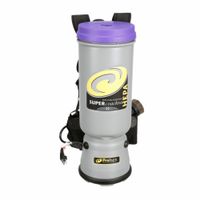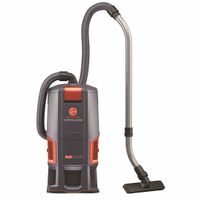Call +(254) 703 030 000 / 751 483 999 / 721 704 777
- Home
- Cleaning And Janitorial
- Floor Cleaning Machines
- Vacuum Cleaners Accessories
- Backpack Vacuums
.....Read More
Frequently Asked Questions
What are the benefits of using a backpack vacuum?
Backpack vacuums offer several benefits, making them a popular choice for both commercial and residential cleaning:
1. **Mobility and Flexibility**: Backpack vacuums are designed to be worn on the back, allowing for greater mobility. This design enables users to move freely and easily navigate around obstacles, stairs, and tight spaces without dragging a canister or upright vacuum.
2. **Efficiency and Speed**: The ergonomic design allows for faster cleaning as users can cover more ground without the need to constantly reposition the vacuum. This is particularly beneficial in large areas like offices, schools, and hotels.
3. **Reduced Physical Strain**: By distributing the weight evenly across the back and shoulders, backpack vacuums reduce the physical strain on the user. This ergonomic advantage minimizes fatigue and the risk of injury, making it easier to clean for extended periods.
4. **Versatility**: Backpack vacuums often come with a variety of attachments and tools, making them versatile for different cleaning tasks. They can effectively clean carpets, hard floors, upholstery, and even high or hard-to-reach areas like ceilings and vents.
5. **Improved Air Quality**: Many backpack vacuums are equipped with advanced filtration systems, such as HEPA filters, which capture fine dust particles and allergens, improving indoor air quality.
6. **Quiet Operation**: Backpack vacuums are generally quieter than traditional vacuums, making them suitable for environments where noise reduction is important, such as hospitals or libraries.
7. **Durability and Longevity**: Designed for commercial use, backpack vacuums are typically built to withstand heavy use, offering durability and a longer lifespan compared to standard household vacuums.
These benefits make backpack vacuums an efficient and practical choice for a wide range of cleaning needs.
How do you choose the right backpack vacuum for your needs?
To choose the right backpack vacuum, consider the following factors:
1. **Purpose and Environment**: Determine where you'll use the vacuum. For commercial spaces, opt for a durable, high-capacity model. For residential use, a lighter, more compact version may suffice.
2. **Weight and Comfort**: Ensure the vacuum is lightweight and has ergonomic straps to prevent strain during prolonged use. Adjustable harnesses and padded straps enhance comfort.
3. **Capacity and Suction Power**: Choose a vacuum with sufficient capacity to minimize emptying frequency. Higher suction power is crucial for effective cleaning, especially on carpets and in high-traffic areas.
4. **Filtration System**: For environments requiring high air quality, such as hospitals, select a vacuum with HEPA filtration to capture fine particles and allergens.
5. **Noise Level**: If noise is a concern, especially in noise-sensitive areas like schools or offices, opt for a model with a low decibel rating.
6. **Corded vs. Cordless**: Corded models offer continuous power, ideal for large areas, while cordless models provide mobility and ease of use in areas with limited outlets.
7. **Attachments and Accessories**: Consider the types of surfaces and areas you'll clean. Ensure the vacuum includes necessary attachments like crevice tools, brushes, and extension wands.
8. **Durability and Build Quality**: Look for models made from robust materials to withstand frequent use, especially in commercial settings.
9. **Budget**: Balance features with your budget. While higher-end models offer more features, ensure they align with your needs.
10. **Brand Reputation and Reviews**: Research brands known for reliability and read user reviews to gauge performance and customer satisfaction.
By evaluating these factors, you can select a backpack vacuum that meets your specific cleaning needs efficiently.
Are backpack vacuums better than traditional vacuums?
Backpack vacuums and traditional vacuums each have their own advantages and disadvantages, making them suitable for different cleaning needs and environments.
Backpack vacuums are designed for mobility and efficiency, making them ideal for commercial settings or large areas. They are worn on the back, allowing the user to move freely without dragging a canister or upright vacuum. This design reduces strain on the arms and back, as the weight is distributed across the shoulders and hips. Backpack vacuums are particularly effective in spaces with obstacles, such as furniture or stairs, as they allow for easy maneuverability. They often come with a variety of attachments for different surfaces and are generally quieter than traditional vacuums, which is beneficial in noise-sensitive environments.
Traditional vacuums, including upright and canister models, are more common in residential settings. They are generally easier to use for those who may not be comfortable wearing a backpack unit. Upright vacuums are often preferred for carpeted areas due to their powerful suction and brush rolls, which are effective at deep cleaning. Canister vacuums offer versatility with their separate hose and wand, making them suitable for both carpets and hard floors. Traditional vacuums typically have larger dust capacities, reducing the frequency of emptying.
In summary, backpack vacuums are better suited for commercial use or large, obstacle-filled areas due to their mobility and ergonomic design. Traditional vacuums are more appropriate for residential use, offering ease of use and effective cleaning on various surfaces. The choice between the two depends on the specific cleaning requirements and personal preferences.
How do you maintain and clean a backpack vacuum?
To maintain and clean a backpack vacuum, follow these steps:
1. **Unplug and Disassemble**: Ensure the vacuum is unplugged. Remove the dust bag or canister, filters, and any attachments.
2. **Empty the Dust Bag/Canister**: If using a bag, replace it when it's two-thirds full. For canisters, empty them after each use to prevent clogs and maintain suction.
3. **Clean or Replace Filters**: Check the filters regularly. Wash washable filters with water and let them dry completely before reinserting. Replace non-washable filters as per the manufacturer's instructions or when visibly dirty.
4. **Inspect and Clean Attachments**: Remove debris from brushes and attachments. Use a damp cloth to wipe them down.
5. **Check the Hose and Wand**: Look for blockages in the hose and wand. Use a long, flexible brush or a straightened coat hanger to clear any obstructions.
6. **Wipe the Exterior**: Use a damp cloth to clean the vacuum's exterior, focusing on areas that collect dust and dirt.
7. **Inspect the Power Cord**: Check for any damage or fraying. Ensure the cord retracts smoothly if applicable.
8. **Check the Motor and Fan**: Periodically inspect the motor and fan for dust buildup. Use compressed air to blow out dust, ensuring the vacuum is unplugged.
9. **Lubricate Moving Parts**: If the vacuum has moving parts, apply a small amount of lubricant to keep them functioning smoothly.
10. **Store Properly**: Store the vacuum in a cool, dry place. Ensure the cord is neatly wrapped to prevent damage.
Regular maintenance and cleaning will extend the life of your backpack vacuum and ensure optimal performance.
What is the average weight of a backpack vacuum?
The average weight of a backpack vacuum typically ranges from 10 to 15 pounds.
Can backpack vacuums be used on all types of flooring?
Backpack vacuums can be used on most types of flooring, but their effectiveness and suitability can vary depending on the specific model and the type of flooring.
1. **Hardwood Floors**: Most backpack vacuums are suitable for hardwood floors. They typically come with attachments or settings that allow for gentle cleaning without scratching the surface.
2. **Carpets**: Backpack vacuums can be effective on carpets, especially low-pile ones. Some models come with motorized brush rolls or beater bars that help agitate and lift dirt from carpet fibers. However, for high-pile or plush carpets, a traditional upright vacuum might be more effective.
3. **Tile and Stone Floors**: These vacuums can be used on tile and stone floors, as they often have attachments that can handle the crevices and grout lines. It's important to ensure the vacuum has a setting or attachment that won't damage the surface.
4. **Laminate Floors**: Backpack vacuums are generally safe for laminate floors, provided they have a soft brush attachment to prevent scratching.
5. **Vinyl Floors**: They can be used on vinyl floors, but care should be taken to use the appropriate attachment to avoid damage.
6. **Area Rugs**: Backpack vacuums can clean area rugs, but the effectiveness depends on the rug's thickness and material. Delicate or high-pile rugs may require a gentler approach.
In summary, while backpack vacuums are versatile and can be used on various flooring types, it's crucial to use the right attachments and settings to avoid damage and ensure effective cleaning. Always refer to the manufacturer's guidelines for specific flooring recommendations.
How long do backpack vacuums typically last?
Backpack vacuums typically last between 5 to 10 years, depending on several factors such as the brand, model, frequency of use, maintenance, and the environment in which they are used. High-quality models from reputable brands tend to have a longer lifespan due to better construction and more durable components. Regular maintenance, such as cleaning filters, checking for blockages, and replacing worn-out parts, can significantly extend the life of a backpack vacuum.
The frequency and intensity of use also play a crucial role; vacuums used daily in commercial settings may wear out faster than those used occasionally in residential environments. Additionally, the type of debris being cleaned can affect longevity; vacuums used to pick up fine dust or abrasive materials may experience more wear and tear.
Proper storage and handling are also important. Storing the vacuum in a dry, cool place and handling it with care can prevent damage to the motor and other components. Some models come with warranties that cover certain parts for a specific period, which can be an indicator of the expected lifespan.
Ultimately, while the average lifespan is 5 to 10 years, individual experiences may vary based on these factors.

